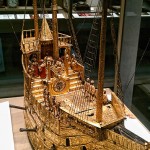By Helen King (W&M Monthly Contributor)
Do you ever feel your dining table needs cheering up?
This week I saw a collection of possibly the last word in ways to impress your dinner guests. I was at the wonderful Kunsthistorisches Museum in Vienna where the Kunstkammer – a selection from the amazing ‘cabinet of curiosities’ assembled by various rulers of the Habsburg Empire – includes a series of automata, mechanical devices that move apparently by themselves. These are elaborate, beautifully made pieces with various moving parts, and some of them play music while the little figures hit their drums and blow their trumpets. My favourite was probably the ship – which, like several of these automata, was created actually to move along the table in front of amazed guests, finally firing its tiny cannons (which looks to me like it would risk giving guests a heart attack, even if it didn’t set fire to their clothing!).
I’ve always been impressed by automata. But I can only begin to imagine the reaction of people in 1585 – no, that date isn’t a typo – when Hans Schlottheim’s ship first sailed across a table. While automata can be disturbing because they very explicitly upset the boundaries between animate and inanimate, living and dead, human and inhuman, would these early examples have been seen as clever artifice or would their viewers have been briefly fooled by what they saw? At a dinner held at a European court, guests would have expected to be amazed and perhaps would be waiting for the moment when their host brought out the latest expensive toy, or speculating as to whether any of the table decorations was about to spring into action. I wonder, though, what the servants would have made of all this? Would they have worried that they were witnessing witchcraft?
But these were certainly not the first automata in the European imagination. The craftsman god Hephaistos is described as making automata; in Homer’s Odyssey we read of gold and silver dogs created by him, which guarded the palace of King Alcinous. How did he do it? According to a description of another of Hephaistos’ automata, a bronze lion, he animated his creations by putting pharmaka in them. Pharmaka is the word used for ‘drugs’; perhaps here it means ‘powerful material’. Although these automata were probably just the product of Homer’s imagination, in the Hellenistic period scientists discussed how these plans could be realised through pulleys, levers, and hydraulic and pneumatic technologies, although scholars still disagree as to whether someone like the first-century AD Hero of Alexandria really made any of the objects he described in his treatise, Automata. What is clear, however, is that the treatise had an enormous influence in the Renaissance, when it prompted learned men to construct the objects described in it – and, in the process, to impress their patrons and their patrons’ guests!
If you’d like to know more:
Christopher Faraone, ‘Hephaestus the Magician and Near Eastern Parallels for Alcinous’ Watchdogs’, Greek, Roman and Byzantine Studies 28 (1987)
Minsoo Kang, Sublime Dreams of Living Machines: The Automaton in the European Imagination (Harvard University Press, 2011) 257-280

